
Atlas F1 GP Editor
Sam Michael's initiation as the new Technical Director of BMW-WilliamsF1 has been a baptism of fire, and the eight Grands Prix since his appointment have seen the team struggle to maintain an already disappointing fourth place in the Championship. But Michael remains calm and pins his hopes on a strong drivers' line-up and overall resurgence in 2005. Atlas F1's David Cameron interviewed the Junior Head of Williams at Spa last weekend
The new millennium has been unkind results-wise to any team not wearing red. Since 2000, Ferrari have won an astonishing 54 races up to last week's result in Spa, as well as every Championship, which doesn't leave a lot left in the pot for anyone else. There is a perception that Williams have been the best of the rest, but in fact in that time they have won a paltry 9 races, against McLaren's more respectable 15.
To put this into perspective, over the preceding five year period Williams took 25 wins, against Ferrari's 21, McLaren's 19 and Benetton's 12.
Williams have clearly under-performed by their own standards, and after falling short in both Championships in a tight year in 2003, most commentators thought that 2004 would be a return to the top for the Grove based team. A radical design philosophy, exemplified in this year's FW26, which was designed with the input of former Ferrari aerodynamicist Antonia Terzi, was thought to be enough to get the job done. It wasn't.
Midway through the season, renowned Technical Director Patrick Head decided it was time to step back and let some new blood have a crack at pushing the team back to their former glories, and 33 years old Chief Engineer Sam Michael was handed the reins. It was a popular move in and outside of the team, as Michael is generally seen being the personification of the Williams Type of Man, but the task he now has on his shoulders is enormous.
In his first race as Technical Director, at the Nurburgring, Williams teammates Juan Pablo Montoya and Ralf Schumacher collided at the start of the race – Ralf retiring immediately and Montoya eventually finishing in eighth.
The next couple of races, however, were somewhat more eventful for Michael - after claiming second and fifth in the Canadian Grand Prix, the team had their results striped when the air ducts on the front brakes were deemed to be outside of the proscribed dimensions, and the following race saw one driver black flagged for failing to switch to the spare car in time and the other hospitalised and out of racing for at least six races following a horrendous shunt in Indianapolis. Not an ideal start by anyone's standards.
Many commentators have suggested that Michael is a Head junior, but in fact there are a number of differences between the men. Whereas Head was famous for his flamboyant and at times loud manner of speaking, Michael is soft spoken, eternally appearing calm. Rather than speaking openly about the team's problems, he is more likely to deflect comments with his dry, slightly sarcastic sense of humour, and he is much more likely to put a positive spin on everything. He is very much a man of his times.
"At the end of the day, you just keep pushing," Michael continues, "and putting in place long and medium term plans to correct things – it's not a matter of falling over or anything like that. Motor racing is tough, and we've made some mistakes on this year's car and we've had a terrible time because of that, but you don't give up – you just turn around and try and put things right."
In Hungary, the team moved away from the radical styling of the car's nose, bringing back a more conservative approach to aerodynamic package but retaining the controversial twin keel chassis design philosophy.
DC: The team made an obvious change of direction with the nose in Hungary. Does that point to an admission of failure with where you were going design wise?
Michael: "Not really – it was good at the time, and really changing the nose is no different to changing the diffuser or a winglet, a flip up, a barge board or anything like that on that car. The only difference is that it's so visual to everybody else. Last year, we changed between one winglet and another probably six times, but no one said (anything) - because it's a winglet, it's not so visual on the car. As far as we're concerned, it's just an aerodynamic device, and we chop and change between those regularly throughout the car's development."
Michael: "It does, but it's no different from any other aerodynamic device. I mean, a front wing endplate or a guide vane are all at the front of the car as well, the same as a front wing flap – we change the front wing flap concepts, with different main planes as well – it's only that the nose is wide and short that it's so visual, so people pick up on it, but to be honest you can try and pick up a bigger story but there's really nothing to it."
DC: The other thing is you went to a twin keel design this year – was that a mistake?
Michael: "We've probably evaluated single keel versus twin keel for the last three or four cars, and we've still got twin keel on this car. But we haven't decided what we're going to do for the next car yet – we're still in the stage of evaluation, and that will continue until we finalise our chassis at the end of the year."
Williams are currently in fourth place in the Constructors' Championship, with McLaren rapidly rising up and looking to overtake. It is unfamiliar territory, and it's clear to see how much it hurts a team that is used to much more. With Toyota already stating that the remainder of the year is effectively a practice for next season, does there ever become a point where a team like Williams could make a similar statement?
"No." Michael is emphatic on this point. "Even if you start to lose the battle for the Championship - and obviously the Championship is gone and it's even looking like getting second and third is not a reality. But the way you finish a year is still important. You need to continue development, and any development on this year's car we can generally carry over to next year's car anyway, so you never turn the year into a development year, if you like – it's all learning and pushing hard on this year to help next year as well."
DC: But there are no guarantees that anything on this year's car is going to end up on next year's car.
Michael: "No, that's true, and because of the regulation changes we don't know how the parts on this year's car are going to be affected by that - there'll be a lot of things that we are developing now for this year's car that won't work on next year's car because of the regulation changes."
Michael: "Well, aerodynamically and chassis wise we're designing to [FIA president] Max Mosley's regulations – well, I wouldn't say regulations, because the exact wording of the sporting regulations and technical regulations still have a few problems with it, which are not intentional. But there are four main changes aerodynamically, which are to lift the front wing 50mm; move the rear wing forward 150mm; trim a 400mm cut out in front of the rear tyre and the diffuser; and lower the diffuser ramps angle so it only goes to 125mm in Z. And we're working on those regulation changes, assuming they're going through."
DC: In the past, Ferrari have stopped the development of their car fairly early to allow them to concentrate on the following year's car, for example in 2002.
Michael: "Yes, and they have this year as well."
DC: That gives them a huge advantage for next year.
Michael: "Yes, it does. It does give them a big advantage and it's pretty hard to overcome, but that's what we've got to do basically, so we've got to push on this year and next year."
DC: What, in your view, do you have to do to overtake them, if you're going to push on until the end of the year with this year's car?
Michael: "We've got to do both, that's the thing; there's no alternative, because we've got to maintain this year's position - you can't give up on this year - and you've got to develop next year's car. Unfortunately, you've got to do both, and that's why whenever you're in a position where you're really competitive or you're uncompetitive it makes the decision easier.
"The problem is, this year the penalty is far greater, because the cars are so different from this year to next year – none of the bits we develop for this year's car will carry over to next year's car – whereas in previous years if you don't have a big rule change you can push right up to Suzuka. All the front wings, engine covers and all that sort of stuff that you develop you can (traditionally) put them onto next year's car, but unfortunately it won't work like that and so it's very expensive in terms of performance to concentrate for too long on this year's car."
DC: But you can't get first, and it's unlikely that you can even make second or third.
Michael: "No, of course, but it's still important – our main target is to maintain fourth, to hold onto fourth."
Michael: "If it's a position in the Championship it's still worth it – at the end of the day, it's in the record books, and you should still go through it."
With this decision, Williams are now in potentially the same situation that McLaren found themselves in last year – they have to split up the factory into different design and engineering groups to concentrate on separate projects rather than focusing all of their resources in one direction. McLaren struggled with the process, and it is only recently that they have been able to turn around their performance, with the team focusing on this year's car.
Surprisingly, Michael believes both teams are of a similar size, stating that "the difference between us and McLaren wouldn't be any more than plus or minus five percent." In any event, both are now running two programmes (pushing this year's car plus designing its successor) and it will be an intriguing battle to watch. What is at stake is, effectively, nothing more than pride – it is arguable that it would actually be better to finish fifth in this year's Constructors' Championship, as that would give the fifth team the advantage of running a third driver on race weekend Fridays next year – and both teams have committed to pushing for fourth place.
If the unthinkable happens and Williams do finish fifth, they will have to consider the third driver programme carefully as well. Stand in driver Antonio Pizzonia will not be able to run on Friday as he has had too many races in the last two years (the sporting regulations state that a third driver must have done no more than six races over that period). Marc Gene, the team's other tester, is a possibility, but his replacement as the race driver, filling in for the injured Ralf Schumacher at France and England, seems to make that move unlikely.
So where would the team look to fill this hole? "It means that you'll have to be looking at a young guy," Michael says. "If you look at the names coming through now, you've got Nelson Piquet Jr and Adam Carroll in British Formula 3 - they're the two hot guys there, both very talented. In Euro Formula 3 Jamie Green is absolutely dominating, Nico Rosberg as well, not bad, and there are two or three other guys out there as well. There are probably five or six names that have got good potential."
Whoever would be brought into the team will have to work with a new driver line-up – Mark Webber has signed a three year deal to race for Williams, and pending the result of BAR's legal case, Jenson Button will also be returning to his old team. After the last few years of internal bickering between Juan Pablo Montoya and Ralf Schumacher, the new front men are seen as a breath of fresh air - and despite both men's relative lack of results to date, it's obvious that the team is relishing the prospect.
Michael: "I think Mark and Jenson will be a fantastic combination, and that's why we're excited about starting them next year – they're both big motivators. They've both got undeniable talent in the car, youth but without greenness as they've both got three or four seasons of Formula One under their belts and have got rid of any sort of problems. They know how Formula One works and what they have to do to push and win, and it's something that we're looking forward to starting as soon as possible – they're Williams type drivers, by a long way."
DC: Jenson already was a Williams driver, of course, but Webber has always struck me as a potential Williams driver – these moves must be a huge motivation for everyone at the factory.
Michael: "It is, it's massive to have that – we haven't had that for a long time, and to get two drivers in there who are pushing each other, pushing the team, makes a massive difference. There are drivers who push the team and there are drivers who don't, and I'm afraid the day where a driver turned up and just drove the car is long gone – if it even existed. The drivers are part of the team and they have to realise that; some of them do, and some of them don't."
DC: Frank, Patrick and you have all stated that you were looking for winning drivers for next year, and although neither driver has won in Formula One yet, they have a clear potential. Tell me what it is that you see in both Jenson and Mark that points towards this?
Michael: "Well, if I start on Mark: every single car that he's got in, he's been fast – whether it be sports cars or go karts or Formula 3 cars or Formula 3000 cars or Formula One cars, straight away he's fast. So that tells you something. And there are only a few guys that are like this that we've seen in history – [Mika] Hakkinen was one of them, Michael [Schumacher] was one of them – they can get into anything and feel the car, know where its limits are on its tyres with not much experience.
"So we've seen that over seven or eight years, watching Mark in various categories, and then when he came into Formula One he's done probably three or four things - and remember, we see a lot more than you guys at testing and in practice sessions, particularly in testing. In testing you do maybe triple the miles of a race weekend, and we see him do things in testing that make you sit up and take notice.
"And we also see him do things in races, even though he might be running around in tenth or something. We keep an eye on everything, especially if we take an interest in a driver. So there's that, and the next thing is his ability against his teammates – he's completely outclassed any of his teammates that he's had. Antonio [Pizzonia] drove with us in testing in 2002 and was regularly quicker than Montoya and [Ralf] Schumacher in testing, and Mark completely dominated him when he was with Jaguar. So that straight away told us that this guy was pretty good.
DC: And Jenson?
Michael: "Jenson at the same time has had a very different career path to Mark, but we had a very good experience with him – it was before I was at Williams, obviously. He was a Williams driver before and everyone in team was a big fan of his, from the engineers to the mechanics and all the factory staff – there's a massive amount of support internally for him.
"As for his talent, you can see how he can drive – you could see that at Hockenheim, for example – and he's got the right mentality, he's very smooth, doesn't get flustered, he's a professional as well, and intelligent enough to understand what makes the cars go fast. I've got a lot of time for Jenson, and I personally pushed very hard, along with a couple of other people inside the company, to get him into Williams."
DC: What do you mean pushed very hard?
Michael: "Well, I wasn't involved in getting him out of his contract with BAR – that's not what I meant. But even before he was available, and for a long time, we were all supportive of him coming to Williams and once his manager contacted us, it was a unanimous decision among us to sign him. It wasn't a hard decision."
DC: How do you see them working together?
Michael: "As far as we're concerned, we'll probably have the best drivers line up outside of [Ferrari's] Michael [Schumacher] and Rubens [Barrichello] - and not because [Button and Webber] are not talented enough, but because they haven't worked together in the team for long enough, whereas Michael and Rubens have been together for a long time now and they do compliment each other pretty well. So that's going to be the strongest combination.
"But Jenson and Mark have both already supported each other and said 'this guy is the best teammate I could have', respectively to each other. I don't expect them to be mates and go to the cinema together or anything like that, but I'm sure they will be fiercely competitive – they've already said so – and I think they'll be strong together professionally and do the job properly.
"So it will be good – I think that it will be very positive for us next year."
The Technical Working Group, a collection of Technical Directors for all of the teams, has been charged with agreeing on changes suggested by FIA President Max Mosley to the Technical Regulations for next year. These changes include the aerodynamic designs (as laid out above by Sam Michael), as well as amendments to the tyres (one set of tyres per race) and the engines (the existing engine is to be modified to last for two races instead of one for 2005, followed by a change to a 2.4 litre V8 engine for 2006).
At present Renault, Ferrari, Sauber, Jaguar, Jordan and Minardi have agreed to the amendments; Williams, McLaren, BAR and Toyota have not.
"At the moment we're assuming the regulations will be as written in Max's document," Michael says. "That's what it will be aerodynamically. We're getting on with it assuming that's not going to change, and I don't think it will because there's general agreement in the TWG with the way they've been written.
"But The final date for agreement is the 6th of September, so until then there's general agreement and anyone can walk into the meeting and say 'is there general agreement on this point?' and people will say yes, yes, no, yes and that sort of thing, but the 6th of September is when you walk in there and say, 'yes I agree to this package' or 'no I don't', and that's the final vote that matters. So there are six teams now, and whether that's two teams or ten teams it doesn't really matter – it's the vote on the 6th of September that really matters."
DC: Can't they get the TWG agreement out of the way?
Michael: "Only if they have eighty percent - there's not eighty percent at this stage. The problem is that the package comprises of aero, tyres, the 2005 engine and the 2006 engine, so there are a lot of things to agree to as a package."
DC: Would it be fair to say that it's the engines that are holding up Williams on agreeing?
Michael: "Most likely yeah – I think that's fair to say. It's most likely fair to say not just in Williams's case, but probably everybody's."
DC: Well, the other four anyway.
Michael: "Yeah – put it this way, if we had a meeting in thirty minutes and Charlie [Whiting] said, "you've all got to decide yes or no on the aero regulations now," I'm quite sure you'd get unanimous agreement, so that probably tells you that those are not the things that are holding it up."
Early this year McLaren team boss Ron Dennis was in the wars – he had suffered the indignity of building a car that was never driven in anger (the MP-18) the year before, and the media pack was baying for blood. After suggesting that the situation had been successfully turned round and that the team were looking toward to wins in the season, Bob McKenzie, long time Formula One journalist for The Express, stated: "if McLaren win a race this year I will run around Silverstone. Naked."
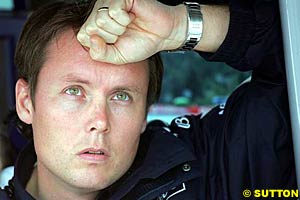 Ron Dennis has a way of polarising public opinion, unlike any other team boss, but why were the McLaren statements treated with such disdain when those of Williams, a team with a similar pedigree, are given a free pass?
Ron Dennis has a way of polarising public opinion, unlike any other team boss, but why were the McLaren statements treated with such disdain when those of Williams, a team with a similar pedigree, are given a free pass?
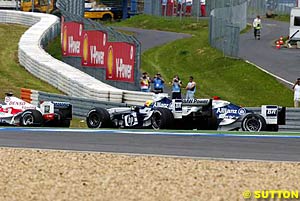 "Well, it's been..." Sam Michael - sat at a table in the team's motorhome in Spa - pauses, refining his words, looking for the correct combination. It is a trait he has in common with team boss Frank Williams. "Obviously we've had a few problems in the last few races, but it's starting to settle down a bit now and we're starting to put in place directions for next year. But the problems we've had have not really been directly related to the change, so it doesn't really bother me. At the end I always think about it, and every race performance is what happens, but you just get on with it and keep looking forward."
"Well, it's been..." Sam Michael - sat at a table in the team's motorhome in Spa - pauses, refining his words, looking for the correct combination. It is a trait he has in common with team boss Frank Williams. "Obviously we've had a few problems in the last few races, but it's starting to settle down a bit now and we're starting to put in place directions for next year. But the problems we've had have not really been directly related to the change, so it doesn't really bother me. At the end I always think about it, and every race performance is what happens, but you just get on with it and keep looking forward."
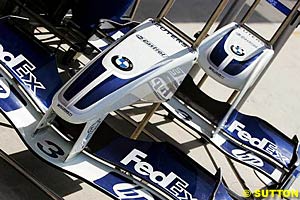 DC: A lot of the aero work flows back from the car, of course, so there must have been a substantial change behind the nose.
DC: A lot of the aero work flows back from the car, of course, so there must have been a substantial change behind the nose.
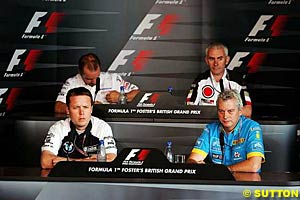 DC: How are you going to design next year's car? There's still no agreement from the Technical Working Group, so what are you going to design to?
DC: How are you going to design next year's car? There's still no agreement from the Technical Working Group, so what are you going to design to?
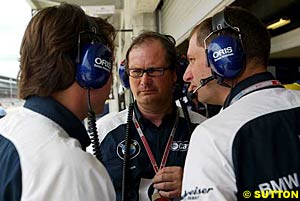 DC: Is the potential penalty for next year worth it? Is there ever a stage where you realise it's better to stop and work on next year?
DC: Is the potential penalty for next year worth it? Is there ever a stage where you realise it's better to stop and work on next year?
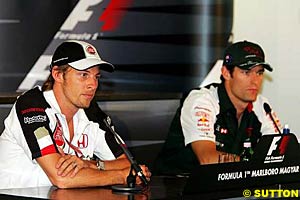 DC: Moving on to next year, how do you see the line-up of Mark and Jenson working out?
DC: Moving on to next year, how do you see the line-up of Mark and Jenson working out?
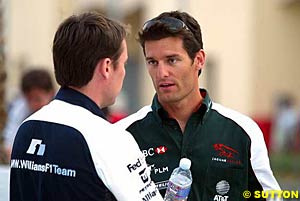 "Then, coming to the personal side and his actual character - when we met him, we realised this was someone who wants to be a Champion. There's a clear difference when you talk to people who understand how they're going to do it – he's an intelligent guy who realises what's required to do the job."
"Then, coming to the personal side and his actual character - when we met him, we realised this was someone who wants to be a Champion. There's a clear difference when you talk to people who understand how they're going to do it – he's an intelligent guy who realises what's required to do the job."
Sidebar: Obstacles on the Way to 2005
|
Contact the Author Contact the Editor |
Please Contact Us for permission to republish this or any other material from Atlas F1.
|
Volume 10, Issue 35
Atlas F1 Exclusive
Summer of Sam
Bjorn Wirdheim: Going Places
Ann Bradshaw: Point of View
2004 Belgian GP Review
2004 Belgian GP Review
Technical Review: Belgium 2004
The Drought Breaks
Stats Center
Qualifying Differentials
SuperStats
Charts Center
Columns
The F1 Insider
Season Strokes
On the Road
Elsewhere in Racing
The Weekly Grapevine
> Homepage |